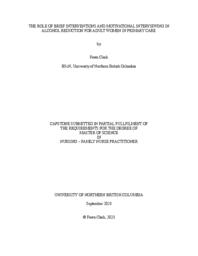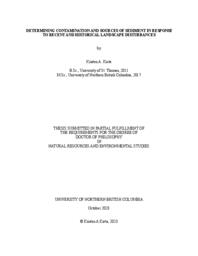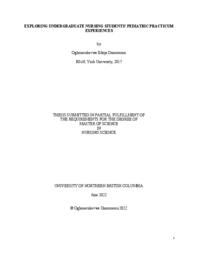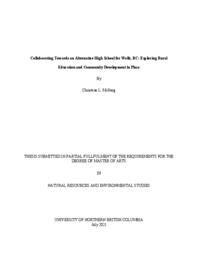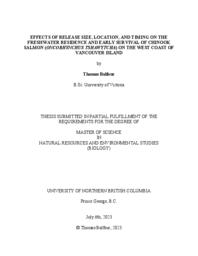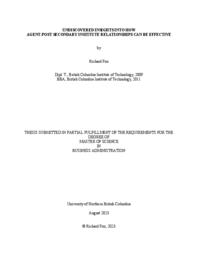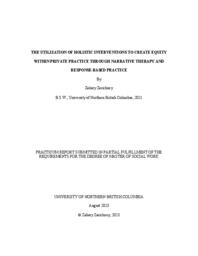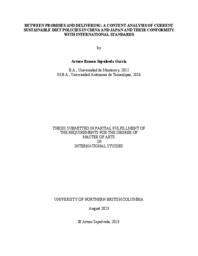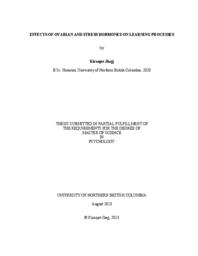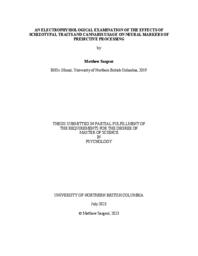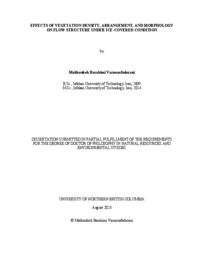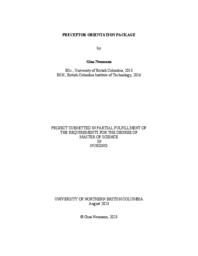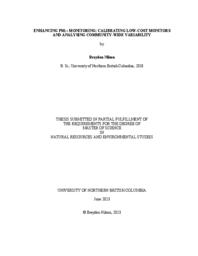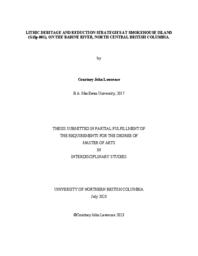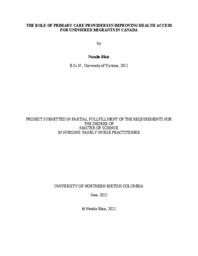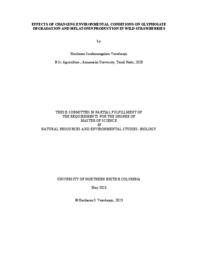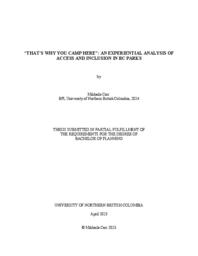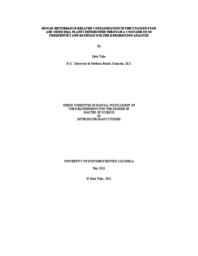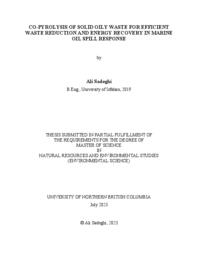University of Northern British Columbia
Related Works
Content type
Digital Document
Description / Synopsis
Alcohol use is a widely accepted part of Canadian society, however the prevalence of use among Canadian women is increasing. Evidence supports that long-term alcohol related risk and harms escalate more dramatically and at lower doses than that of men, yet research is limited on appropriate interventions for adult women not otherwise captured within obstetric care. Although adult women are frequent users of primary care, screening, and early intervention for problematic drinking is lacking. The purpose of this integrative review is to appraise the existing evidence to determine the role of brief interventions and motivational interviewing in reducing alcohol consumption for adult women in the primary care setting. Recent guideline updates in Canada’s Guidance on Alcohol and Health (Paradis, 2023) to reduce health impacts of alcohol on women, as well as the sex and gender related factors that contribute to health effects of alcohol on women demonstrate the importance of prevention and early intervention. Brief interventions and motivational interviewing have shown limited effectiveness for improving awareness of health effects of alcohol on women and reducing alcohol intake in a patient centered care model. Further research is recommended to improve the quality of evidence and generalizability of practice standards of alcohol use health care related to adult women for primary care providers such as nurse practitioners, family physicians and other allied health professionals.
Origin Information
Content type
Digital Document
Description / Synopsis
Landscape level disturbances occur in nearly every watershed throughout the globe, and as the climate changes, these disturbances will continue to have a significant impact on terrestrial and aquatic ecosystems. Wildfire, timber harvesting, and agricultural expansion are only a few of these disturbances, but each uniquely impacts the sediment regime. While sediment is a necessary and beneficial input to streams and rivers, it also can have negative impacts on the aquatic ecosystem because it can carry contaminants and also be physically detrimental when it settles, clogging spawning habitat. All of these disturbances have occurred historically and in the present in the Nechako River Basin (NRB), a large, regulated watershed in north-central British Columbia, Canada. In the NRB, chinook and sockeye salmon and the Nechako White Sturgeon are species that have been declining in population, in part due to the clogging of their habitat by sand and fine sediment. One way to determine sources of sediment is by using the sediment fingerprinting technique, whereby sediment samples and samples from potential sources are collected and analyzed for a series of physical or biogeochemical properties, and the proportion of sediment coming from each potential source is identified using an unmixing model. After catastrophic wildfires in 2018, research was undertaken to determine the spatial and temporal contamination of soils and sediment by polycyclic aromatic hydrocarbons (PAHs), to determine if burned areas were contributing more sediment than unburned areas to tributaries and the Nechako River mainstem, and to determine the suitability of PAHs as a novel fingerprint. The results found that concentrations of PAHs in the burned soils were elevated immediately post-wildfire, but decreased significantly in subsequent years, and concentrations in sediments were very low. While PAHs were deemed to be non-conservative properties, unmixing modeling using colour showed that burned sources were an important contributor to the tributaries, but less so in the mainstem Nechako River. Agriculture is an important and growing industry in the NRB and is also an important source of sediment. Results from fingerprinting research undertaken in Murray Creek, an important watershed due to its proximity to spawning habitat, found that agriculture was the primary source of sediment in the basin, though channel banks were also important. While the intention was to use compound specific stable isotopes of long chain fatty acids to more specifically pinpoint agricultural fields that were contributing more sediment to the watershed, this semi-novel tracer was unable to discriminate between C3 plant types on a large scale. Taking the entire disturbance regime of the NRB into account, a broader scale fingerprinting study found that sources of sediment are tributary specific, though banks and agriculture were consistently most important. This study also identified that the predicted shift to a rain dominated watershed and earlier freshet will lead to increased potential for erosion from various sources, and that increased incidence of wildfire followed by heavy precipitation may increase sediment loads. Therefore, a number of management changes are suggested, including improving farming practices, post-wildfire landscape rehabilitation, and altering water release practices.
Origin Information
Content type
Digital Document
Description / Synopsis
Practicum placements are the signature method used in undergraduate nursing programs to consolidate knowledge in practice. The literature review conducted before this study showed limited research on pediatric practices in undergraduate nursing education. This qualitative descriptive study, analyzed within Knowles’ (1977) adult learning theory framework, explored the practicum experiences of nursing students and the value they ascribed to their learning experience. The acute and community pediatric practicum experiences of 13 undergraduate nursing students and two recent graduates in British Columbia were explored using semi-structured interviews. Thematic analysis of interview data generated four overarching themes: relational practice, knowledge consolidation, identity formation, and exposure. Findings from the study indicated that nursing students valued pediatric placement opportunities that provided a variety of learning experiences and allowed them to work within their perceived scope. Information from this study can inform the planning and management of pediatric practicum experiences for nursing students in undergraduate nursing programs.
Origin Information
Content type
Digital Document
Description / Synopsis
This thesis examines how rural communities are at risk to wildfire hazards through a case study of the Robson Valley, British Columbia, Canada. The research is guided by a vulnerability approach, which conceptualizes risk as a function of how a community is exposed and sensitive to a hazard and its capacity to adapt. Data were collected using semistructured interviews with policymakers, forest professionals and emergency managers alongside community meetings in three rural areas, participant observation, and analysis of secondary sources. The findings show that while most communities in the Robson Valley are not directly at risk from extreme wildfire hazards, they are indirectly exposed and sensitive to secondary and tertiary impacts, due to a single power transmission and road transportation route, that are both highly exposed to wildfire hazards. The centralization of government services has led to a change in the ways that wildfires are suppressed, which can be incongruent with diverse land values and attitudes about responding to hazards held by longtime residents and local First Nations. This thesis concludes with recommendations for how to better engage rural communities in fire prevention and suppression including the creation of a community champion position and improved legislation allowing for the participation of rural residents in fire suppression operations.
Origin Information
Content type
Digital Document
Description / Synopsis
Rural high schools are often the heart of rural towns, as they can have significant social, cultural, and environmental contributions to community life. The absence of a high school can impact students' mental, physical, and social health and the entire community's social and economic well-being. This research used Community-Based Participatory Research to examine rural education and community development processes using place-responsive approaches in the rural town of Wells, BC. Wells is a unique, dynamic, artsy community in the BC interior and does not currently have a high school. Results suggested that a lack of a high school in Wells had reverberating social and economic effects on individual and community life. Understanding these effects can allow community members to target unique opportunities that counter impacts. Community approaches to alternative education integrated place-responsive, community-, outdoor, and art-based education that reflected community values. These values can be incorporated into educational models and programs to respond to context-specific community desires and needs. Research results can be referred to when determining future directions for local education in Wells and inform more global applications of educational and rural place-based community development policy and practices.
Origin Information
Content type
Digital Document
Description / Synopsis
Hatchery enhancement of declining Pacific salmon populations has long been a foundation of salmon management; however, the influence of hatchery release practices on freshwater residence time and survival to estuarine entry is not well-understood. This study employed Passive Integrated Transponder (PIT) tags to evaluate the relationships between the size of individuals at release, release location, and release timing on the duration of freshwater residence and survival of hatchery-produced Chinook salmon (Oncorhynchus tshawytscha) in the 103 km2 Toquaht River watershed, located on the west coast of Vancouver Island, British Columbia. The Toquaht River mainstem is ~22 km in length, divided into upper and lower sections by the 118 ha Toquaht Lake. A total of 4848 PIT-tagged Chinook salmon smolts were released on three dates (May 23rd, June 9th, June 19th), and during each release, fish were split evenly between three different locations within the watershed (Toquaht Lake: 7.9 km from the detection array; upper river: 11.9 km from the array; and the lower river: 4.1 km from the array). The detection data were analyzed using an integrated model of freshwater residence and capture–recapture fitted using Bayesian inference. The duration of freshwater residence between release and detection ranged from 0.5–60 days, with a mean of 14 days, and exhibited a negative relationship with fish size. The estimated median survival probability for all locations and dates was 0.39, with the highest probability of survival (0.78) found in fish released into the lake on June 19th and the lowest (0.06) for lower-river fish released on June 9th. Changes in streamflow were likely responsible for the observed pattern in survival by date. Survival probability decreased as fish size increased. Overall, the study provides further evidence that hatchery release strategies can significantly influence freshwater residence and survival, and these practices should be well-understood and flexible in the face of changing environmental conditions. The results of this study may have significant implications for the management of Toquaht River Chinook salmon, particularly in the context of ongoing efforts to rebuild the naturally spawning population.
Origin Information
Content type
Digital Document
Description / Synopsis
Forest ecosystems and the ecological services they provide are complex and dynamic. Disturbance and successional processes impact habitat for animals such as caribou (Rangifer tarandus caribou Gmelin 1788, Banfield 1961, 1974) and moose (Alces alces L.). The forested winter habitat of the Tweedsmuir-Entiako caribou herd has been significantly affected by recent disturbance. In order to evaluate the mid- and long-term consequences for habitat, we require an understanding of how habitat attributes change as stand structure changes over time. I developed a framework to link a stand dynamics model (SORTIE-ND), via linker functions, to three ecosystem elements relevant to caribou populations: terrestrial forage lichen, moose forage, and vertical cover. I first used SORTIE-ND to model stand structure dynamics following mountain pine beetle (Dendroctonus ponderosae Hopkins) attack and clearcut harvesting. I developed linker functions and refined them with empirical data. These functions were applied to stand structure output from SORTIE-ND to project the response of habitat to the disturbance agents. I addressed three questions: 1. What is the influence of edaphic site on the provision of elements of caribou habitat over time? 2. What is the influence of stand type on the provision of elements of caribou habitat over time? 3. How do recovery trajectories of caribou habitat elements differ in response to disturbances such as mountain pine beetle and clearcut harvest? I found that site and stand type interacted to influence the suitability of terrestrial lichen, moose forage and vertical cover. Poor productivity sites were most favourable for terrestrial forage lichen. Higher productivity stands and broadleaf stands provided the greatest suitability for moose shrubs. Both mountain pine beetle attack and clearcut harvest improved stand suitability for lichen and moose browse though for different sites and stand types. Interestingly, I found that severe mountain pine beetle attack resulted in conditions that favoured forage lichen for longer than clearcuts. Clearcuts resulted in conditions that were more suitable than mountain pine beetle attack for winter forage for moose. When operating on landscapes with caribou winter habitat, forest managers should consider disturbance history, the distribution of sites and stand types, silviculture systems and the future desired state of ecosystem services. The SORTIE-ND modelling framework could be used to support the evaluation of alternative management decisions in caribou winter habitat including alternative silviculture strategies. This approach could also provide stand- and site-specific trajectories of the recovery of caribou habitat that could be applied to habitat supply models.
Origin Information
Content type
Digital Document
Description / Synopsis
Canadian universities are increasingly reliant on their recruitment agency partners (Agents) to achieve their international recruitment targets, and improve efficiency, flexibility, and ensure a sustainable market presence. It is unclear if the relationship between Post-Secondary Institutions (PSI) and Agents is mutually sustainable, or what factors promote a successful Agent-PSI relationship. This study explores the Agent-PSI relationship from Agents’ perspectives through the use of an analytical lens informed by supply chain theories. I aim to understand relational factors that drive satisfaction from agents’ perspectives. This study uses a theoretically driven model to analyze the survey data of 91 respondents to determine positive relational factors. Initial surveys were followed by semi-structured interviews of randomly selected respondents to provide additional analysis into data anomalies. The findings show that Relationship Trust led to improved Agent-PSI satisfaction, which leads to a mutually sustainable partnership.
Origin Information
Content type
Digital Document
Description / Synopsis
During my years in the social work field, I have worked with diverse and vulnerable populations, and I have found that clients face barriers that impede their ability to access mental health services. This has become more relevant to society as years pass and more struggles are identified, such as financial, organizational, and systemic impediments. Within my practicum placement at Currents Counselling and Consulting, I encouraged an environment involving equity within social work and private practice. I did this through narrative therapy and responsebased practice with the enmeshment of spirituality and holistic interventions. I was able to adhere to professional practice frameworks consistent with the British Columbia College of Social Workers (BCCSW) Code of Ethics. I aim to call into question how Westernized society has defined what evidence-based practice consists of and what could be used as appropriate interventions. As society evolves, we see significant benefits from approaches and interventions involving more holistic and spiritual perspectives. This report also discusses my practicum experiences, implications, need for ongoing involvement, effective self-care, and concludes with recommendations for social work practice.
Origin Information
Content type
Digital Document
Description / Synopsis
Industrial land-use has had profound impacts on Indigenous peoples’ homelands throughout Canada. Over the last century, logging practices in British Columbia have severed peoples’ connections to the land-base, creating access challenges and disrupting the availability of important plant resources. Devil’s club (Oplopanax horridus) is an important medicinal plant to communities in northwestern British Columbia, and there are mounting concerns about the impacts of logging on this ethnobotanically salient species. Over the last 70 years, swathes of productive forests throughout Gitxsan homelands have been impacted by the logging industry. Wilp (house) Luutkudziiwus has seen ~12% of their territory of Madii Lii altered by industrial-scale clearcut logging, which has left a mosaic of even-aged cutblocks that have potentially altered devil’s club habitat. To investigate and detail the potential impacts of logging on devil’s club in Madii Lii territory, this research measured devil’s club health and vigour across a chrono-sequence of clearcut-logged sites compared with traditionally managed and unlogged sites in the territory. In addition, Species Distribution Models in conjunction with two different climate change scenarios (SSP245 moderate GHGs and SSP585 high GHGs) were used to predict habitat suitability for devil’s club in Madii Lii and throughout British Columbia to the end of the 21st century. Results suggest that, compared to traditionally managed areas (and controls), extensive logging in the territory negatively impacted the health and vigour of devil’s club, especially the most desirable individuals (with the largest and thickest stems). In addition, the predictive modelling for both climate scenarios suggest that climate change will increasingly impact highquality devil’s club habitat.
Origin Information
Content type
Digital Document
Description / Synopsis
This thesis examines current national sustainable diet policies in China and Japan and their conformity with the Sustainable Healthy Diets policy guidelines proposed by the FAO and the WHO. Qualitative content analysis is used to identify the level of conformity, policy themes, and objectives of the texts of the policy documents. MaxQDA 2022 text-based analytic software was used to organize and enable a close reading and a line-by-line coding of the analyzed policy documents. The content analysis method proved useful in examining the policy documents and revealing their themes, objectives, and level of conformity with Sustainable Healthy Diets. The current policy of China has an overall low level of conformity, whereas the Japanese policy has an overall medium and high levels of conformity.
Origin Information
Content type
Digital Document
Description / Synopsis
Learning is controlled by two interacting processes, cognitive and habitual learning. How these two systems are used while we learn in our everyday lives depends on an individual’s context. For example, stress is one contextual factor that consistently has created a shift toward habitual learning. In addition, there is evidence that ovarian hormones can also influence learning processes. However, research investigating these hormonal influences has resulted in inconsistent findings. While there is evidence that both of these contextual factors influence learning processes, there is little research on what effects result from their interaction. Further, while the menstrual cycle is often used to approximate ovarian hormone levels in such studies, it is conceptualized strictly as a biological phenomenon, despite evidence supporting its biopsychosocial characterization. Thus, the current study investigated the individual and interactive effects of chronic stress and ovarian hormones on learning processes, while using a biopsychosocial understanding of the menstrual cycle. Participants (N = 32) completed a probabilistic classification learning task. They also provided salivary measures of estradiol and progesterone, and completed measures of chronic stress and menstrual-related attitudes and beliefs. Results revealed a trending association between progesterone and learning processes. Further, there was an interaction between chronic stress and estradiol in predicting learning process use. Lastly, there were significant correlations between learning processes and various menstrual beliefs. As such, these preliminary results revealed how ovarian hormones and chronic stress interact to influence learning processes, and menstrual attitudes and beliefs can provide a more detailed understanding of these effects.
Origin Information
Content type
Digital Document
Description / Synopsis
The brain’s ability to make predictions has long been of interest to cognitive neuroscientists, who have used techniques including electroencephalography (EEG) to study this phenomenon. A component of neurophysiological activity, termed the Semantic Predictive Potential (SPP), may be an indicator of people’s ability to predict the nature of upcoming semantic content. Interestingly, a body of theoretical and experimental work suggests that people with schizophrenia and people who regularly use cannabis have difficulty making predictions about information in their environments. We explored how schizophrenia-like traits and cannabis use affected the SPP. Participants read sentences which differed in the predictability of their endings while brain activity was monitored using EEG. Participants then completed questionnaires assessing their levels of schizophrenia-like traits and cannabis use. We replicate previous findings suggesting that the SPP is sensitive to semantic predictability, and show that schizophrenia-like traits and cannabis use interact with semantic predictability to influence the SPP.
Origin Information
Content type
Digital Document
Description / Synopsis
Aquatic vegetation appears very often in rivers and floodplains, which significantly affects the flow structure. On the other hand, a common feature of cold regions is the presence of river ice on water surfaces. Ice cover imposes an additional boundary layer on water surface which leads to significant change in flow structure and bed deformation. It also causes a decreasing trend of velocity profile near the cover. Because of vegetation’s positive impacts on water quality, habitat, and channel stability, researchers now advocate replanting and restoring projects in rivers, especially in agricultural waterways, floodways, and emergency spillways. The expansion of vegetation in fluvial systems may worsen the flood impact since highly dense vegetation in a channel reduces its flow capacity due to the increase in flow resistance and decrease in the channel width. Therefore, an accurate and critical assessment of the vegetation density and distribution pattern through reduction of bulk velocity is crucial in sustainable restoration projects. To the author's knowledge, no studies have been conducted to investigate the impacts of both ice cover and vegetation on flow resistance and channel bed deformation. It is thus necessary to examine the connection between vegetation and ice covers thoroughly in order to guarantee successful restoration projects. Most of research projects on submerged vegetation have been done in small-scale laboratory flume and specifically under the open channel flow condition. Besides, most of reported research uses uniform sediment which is not an appropriate representative of natural river systems. In the present study, deflected and non-bending model vegetation elements arranged in both square and staggered configurations with different density in the channel bed with three different non-uniform sands under different cover conditions of water surface including open channel flow and ice-covered flow conditions were used. In order to simulate the ice cover condition, smooth and rough ice covers made of Styrofoam panels were created to investigate the impacts of ice cover roughness on channel bed deformation. To represent non-uniform sediment condition, three different bed materials with median particle size (D50) of 0.50 mm, 0.60 mm, 0.98 mm were used. Results showed that the most significant variable influencing the depth of scour holes under ice-covered flow conditions is the ratio of the ice cover roughness to the bed roughness and in open channel flow conditions, the flow Froude number is determining. In the conducted experiments, it was consistently observed that the maximum scour depths occurred at the upstream, front face of the vegetation elements. It was found that the scour holes were deeper and longer under ice-covered flow. In the presence of vegetation in the bed under ice-covered flow conditions, the velocity profiles exhibit a distinct pattern characterized by two peak values. The study revealed an inverse relationship between canopy density and the dimensions of the wake zone. As the spacing distance between deflected vegetation elements decreases, the streamwise velocity experiences significant retardation slightly below the inflection point. With a sparser vegetation canopy, the inflectional region tends to diminish or disappear. Furthermore, the study observed that the inflection point was not observed in non-bending vegetation. Additionally, velocity profiles showed more pronounced inflection points in the case of a staggered arrangement of vegetation elements compared to a square arrangement. Results of this study will provide vital information for river management, channel restoration, and rehabilitation of fluvial environments through understanding the effect of various vegetation densities, arrangement patterns and morphology, as well as the revitalization of cold-weather river ecosystems.
Origin Information
Content type
Digital Document
Description / Synopsis
Scholars have been calling for the integration of the natural environment within social work for over thirty years. However, the literature provides little insight into youth perspectives on their relationships with land and place, particularly in rural and remote communities. In fall 2022, I interviewed twelve students ages 14-17 at Fort St James Secondary School in BC’s Nechako Lakes District (School District 91) about their experiences spending time outdoors. By student choice, half of these interviews took place inside their school and half took place in outdoor settings nearby the school. Through reflexive thematic analysis, I developed five themes from our interviews, including (1) Specificity in relationships: Where we are (and who we are) matters; (2) Pathways to negotiating relationships with land and place; (3) Intersections of community, land, and youth resilience; (4) People are connected through place and time; and (5) Youth have agency and responsibility. My discussion links youth relationships with land and place to social work practice and highlights connections between the resilience of youth, their communities, and the land and water they rely on. This research contributes to a growing body of literature on social work and the environment and identifies future avenues for the integration of land and place within research.
Origin Information
Content type
Digital Document
Description / Synopsis
The purpose of this project was to create an evidence-informed preceptor orientation package that would help nursing preceptors understand the essential components necessary to prepare for the preceptor role of BSN students in their final practicum in Level 3 Small Community Hospitals (21-100 beds) within the Interior Health Authority (IHA) in British Columbia. It was done in collaboration with IHA to fill a gap in preceptor education for registered nurses working with final practicum BSN students. A literature review identified key evidence-based nursing preceptor education concepts, which were integrated into a preceptor orientation package. The preceptor orientation package includes learning objectives and resources related to the role and responsibilities of the preceptor, goal-oriented preceptorship and learning styles, guiding a reflective discussion and feedback, creating a safe and supportive learning environment, and the preceptor’s motivation. The package's evaluation and implementation are explored, and the author's critical reflection concludes the paper.
Origin Information
Content type
Digital Document
Description / Synopsis
In the last 40 years, neoliberalism has become the dominant political economy, guiding not only global economies and politics, but also every other aspect of contemporary life, including the management and planning of national parks and equivalent reserves, and global conservation goals and objectives. Despite a growing body of academic research on the impacts of neoliberal conservation, there is still a need for studies that explore the issue from a comparative, international perspective and examine its different repercussions on nations with different historical, social, and geographical contexts. An interdisciplinary approach, combining the data analysis methods of critical discourse analysis, Foucauldian discourse analysis and historical institutionalism was used to perform a comparative case study between national park systems in Canada and Brazil. The research identified the main path dependencies, as well as the periods of stability, and internal and external aspects that shaped the national park systems in both countries. Discourses used to promote or resist the adoption of market-based instruments and other neoliberal policies were also identified and grouped into three larger discursive formations: 1) Public funding is the ideal model for national parks; 2) There is no alternative to the market for national parks; and 3) The market is the best solution for national parks. The results suggested a double standard between Canada and Brazil related to their position in the world-system as core and peripheral nations. Discourses were used to promote neoliberal policies as the best and only solution for national parks, but the external and internal pressure for their implementation was more geared towards peripheral countries while core countries had more power to decide which policies would be adopted. Foucauldian discursive strategies were used to provide an alternative way to understand how core nations and international organizations work to control the discourses that are available to peripheral countries.
Origin Information
Content type
Digital Document
Description / Synopsis
Many animals spend a considerable amount of time within a shelter, and shelter availability can influence the distribution, abundance, and diversity of animal populations. Shelters used during winter, when ambient temperatures are low (< 0°C), must provide animals with adequate protection to survive through months of adverse conditions. For bats, shelters (roosts) used during winter must also provide microclimates that support energetic requirements for hibernation. Silver-haired bats (Lasionycteris noctivagans) are a tree-roosting species that are migratory throughout much of their range. In parts of northwestern North America, however, they may hibernate locally. Hibernation sites (hibernacula) in regions where winter temperatures are below freezing are typically caves, underground mines, or rock crevice features, as these protect bats from cold temperatures and provide a humid environment that prevents dehydration. In a forested area near Beasley in southern British Columbia, silver-haired bats use an abandoned mine, rock crevices, and trees as roosts during winter. The use of trees as roosts during winter in cold regions (average temperatures < 0°C) is poorly understood. I sought to investigate the winter ecology of tree-roosting silver-haired bats in southern British Columbia. In Chapter 2, I described the characteristics of trees used as hibernacula by silver-haired bats. I hypothesize that bats select winter roost trees non-randomly, and differently across seasons. In Chapter 3, I investigated microclimates and torpor patterns inside silver-haired bat mine, tree, and rock crevice hibernacula. I hypothesize that microclimates vary among winter roost types, and because of these differences, torpor, arousal and movement patterns will differ among tree, rock crevice and mine winter roosts. A majority (66.7%, n = 22) of silver-haired bats used trees as winter roosts during the study. Winter tree roosts were selected non-randomly, and compared to summer roosts, bats used features that provided insulation, such as, cavities in large-diameter, low-decay trees in areas of low canopy closure. Winter trees roosts were colder but more humid compared to the mine and rock crevice roosts. Bats switched among roosts throughout winter depending on ambient conditions but did not alter torpor patterns among roost types. Bats typically used humid roosts (trees) on drier days, and less humid roosts (mine) on more humid days. Further, bats used the well-insulated mine on colder days, and poorly insulated trees and rock crevice roosts on warmer days. Despite this, bats showed more tolerance for colder roost temperatures than expected, remaining in trees during periods of cold (-9°C) temperatures. I conclude that there may be a trade-off between roost humidity and temperature, with bats using multiple hibernacula to optimize energetic benefits in the context of ambient conditions. Trees are an important part of silver-haired bat winter ecology. The use of trees as hibernacula needs to be better understood to inform forest management decisions that better support silver-haired bat conservation by protecting important winter roosts
Origin Information
Content type
Digital Document
Description / Synopsis
Fine particulate matter (PM2.5) air pollution is a significant health concern for the global population. The increasing frequency, intensity, and duration of wildfire smoke events continues to worsen people’s exposure, regardless of their proximity to other major sources such as industry and roadways. To mitigate this exposure, it is crucial to understand the variability of PM2.5 in both space and time. However, the current PM2.5 monitoring network in Canada is limited to major population centres, due to the prohibitive costs of maintenance and deployment. In this study, we propose that low-cost air quality monitors are a viable solution to supplementing this monitoring network. Chapter 2 presents a comprehensive evaluation of these low-cost monitors by comparison with monitors from regulatory networks, including the development of a general-use bias correction model to improve their data quality. The focus of this analysis was to ensure optimal performance in the moderate to high concentration range, where variations in the concentrations have the greatest impact on human health. Chapter 3 demonstrates the application of this bias correction model to a network of low-cost monitors in a northern Canadian city. The data generated by this network was then combined with a novel interpolation method to assess the spatial and temporal variation in PM2.5 concentrations. This analysis represents a valuable resource for any population centre with a sufficient number of monitors installed, and has the potential to inform the siting of new regulatory monitors in locations without existing coverage.
Origin Information
Content type
Digital Document
Description / Synopsis
The Babine Archaeology Project began in 2010 and since then, many stone artifacts have been recovered. In 2014 and 2015, the project focused on excavations on Smokehouse Island (GiSp-001), on the Babine River. The focus of this thesis is an analysis of a sample of debitage recovered from Unit 8 excavated in 2015. The goal is to determine if differences are evident in how the inhabitants of Smokehouse Island reduced the different stone raw materials. Mass analysis, a modified version of the Sullivan and Rozen technique, and Magne’s scar count method were used to analyze the materials. Results suggest that core reduction is dominant for the two different raw material groups, though tool production is still present for both. Technological mixing impacts the analysis of the different materials.
Origin Information
Content type
Digital Document
Description / Synopsis
The purpose of this capstone project was to explore the question: How can primary care providers improve health access for uninsured migrants in Canada? An integrative literature review was conducted, followed by a comparison and analysis of the available literature. Much of the existing literature discusses the barriers that uninsured migrants face in Canada. There was very little research specifically directed towards primary care providers who work with uninsured migrants in Canada, and even fewer recommendations of tangible ways for primary care providers to improve health access for this vulnerable community. There were many limitations to researching the uninsured migrant community and because many of the health barriers uninsured migrants face are systemic and intersect with immigration, federal, and provincial legislation, many recommendations that exist in the literature would be considered outside the scope of a primary care provider. The project concludes with recommendations translated from the literature for primary care providers and provides suggestions for future research.
Origin Information
Content type
Digital Document
Description / Synopsis
Glyphosate is a broad-spectrum herbicide commonly used in Canadian forests to control competitive vegetation. The non target plant species are exposed to a sublethal dose of glyphosate-based herbicides (GBH) due to aerial applications that cause deformities along with other potentially unknown effects. The efficiency and degradation of glyphosate to its metabolic by-products, including amino-methyl phosphonic acid (AMPA), are based on environmental conditions and the genetic capabilities of the plant or exposed organism. Glyphosate enters the plant through foliage and blocks the production of aromatic amino acids such as tryptophan by inhibiting the plant enzyme 5-enolpyruvylshikimate-3-phosphate synthase (EPSPS). Interestingly, the amino acid tryptophan acts as the precursor of the plant stress response hormone called melatonin. Whenever a plant is exposed to biotic or abiotic stress, the level of melatonin increases to protect the plant. The production of melatonin also tends to change depending on the environmental conditions. Glyphosate-based herbicides may act as a chemical stress, and the plants may respond to it by increasing melatonin concentration. The objectives of this research were: 1)To find out how environment, in this case, measured by the effects of the combination of temperature and photoperiod, affect plant stress responses to GBH application, and to determine which combination of temperature and lightsupported the faster degradation of glyphosate to its secondary metabolite AMPA; 2) To determine the effects of changing environmental conditions and GBH application on a plant’s melatonin production. I used wild strawberries (Fragaria virginiana) as my experimental species as they are a common understory species grown in the forest areas of British Columbia, Canada, where GBH is sprayed, and are also of importance as food to humans and wildlife. I used 1080 g/m2 of GBH treatments in my experiment to replicate the sublethal dose received by the non-target plants in industrial operations. Several plant stress responses were observed during the measurement period in three different trials. Trial 1 had different temperatures with constant photoperiod, trial 2 had different photoperiods with constant temperature, and trial 3 combined variation in temperature and photoperiod. At the end of experiment, I found that GBH were highly effective at 20°C with 18 hours of photoperiod as it affected several plant morphological features. The degradation of GBH were maximum at 20°C with 24 hours of photoperiod as suggested by the degradation ratio of glyphosate and AMPA. The new leaves produced by the plants after GBH application were more sensitive to glyphosate as leaf area and photosynthetic capacity by the new leaves were severely affected compared to the previously emerged leaves. Melatonin levels were altered by temperature, week of sample collection and slightly by photoperiod. The production was not affected by GBH application. These results suggest that wild strawberries grown in forest areas with warmer temperatures are most highly affected by glyphosate applications and when warm temperatures are accompanied by longer duration of sunlight, faster degradation of glyphosate is facilitated in tissues.
Origin Information
Content type
Digital Document
Description / Synopsis
It is well established in the literature that nature can provide a host of benefits to human health and wellbeing. However, access to outdoor recreation and nature-based tourism spaces remains inequitable, as park planning and management processes have not prioritized access and inclusion for all. Many studies have documented an overwhelming presence of physical, attitudinal, and informational barriers to accessing nature for persons with disability (PwD). These studies highlight an overwhelming presence of physical barriers and a lack of reliable and comprehensive accessibility information essential to enabling efficient trip planning processes. This research draws on the knowledge and lived experiences of a small group of people living with diverse impairments, in outdoor settings. Field observations utilizing a photovoice methodology and reflective journals were used to document interactions of PwD with (in)accessible nature spaces in two BC Parks regions. A thematic analysis of this data uncovered three emergent themes related to access and inclusion: the importance of access the key features, the availability of cognitive space to fully embody experiences, and information delivery on and off site. Findings from the project demonstrate how BC provincial parks might be experienced by individuals with a range of embodiments in nature. Place-based narratives using creative analytic practice weave the experiences of PwD in this research and objective standards data (e.g., measurements of infrastructure) to produce a diverse type of information that can enable trip planning processes for PwD.
Origin Information
Content type
Digital Document
Description / Synopsis
Increased development in forestry, oil and gas, road infrastructure, and agriculture sectors across the Swan River Watershed (Alberta, Canada) has led to an increase in the impact they have on the riparian and aquatic ecosystems. These industries require the removal of vegetation for construction and operation, and some do not require buffer zones around waterbodies to protect aquatic habitat. These industries also use herbicides and fertilizers that may contain high levels of heavy metals, as well as glyphosate. In this thesis, I examined the changes to abundance of plant species chosen by Knowledge Keepers of the Swan River First Nation, as well as general plant categories (i.e., shrub, trees, and herbaceous), in relation to industrial development. I also examined how heavy metal and glyphosate content changed in these plant species with distance from industrial development. Sixty-seven sites were sampled across the Swan River Watershed, each with seven transects examining plant abundance. Tissue samples of chosen species were collected on the first, fourth, and seventh transects. I found significant ( = 0.05) changes to the abundance of aquatic and riparian plant species and categories in association with industrial activity. I also found significant ( = 0.05) changes to heavy metal concentrations in response to industrial presence and distance. There was a significant ( = 0.05) increase in the presence of glyphosate in plant species when forestry or agriculture were present at a site. These results were obtained after conducting a comparison of multiple Bayesian and frequentist regression analysis. There has been an increased interest in Bayesian analysis in ecology, however there is still some hesitation around its implementation due to hardware and software costs, time, and education. The Bayesian method resulted in smaller root-mean-squared-errors and increased precision. I also found that the time and costs were the same as the frequentist analysis, when using a dataset collected over one field season. The biggest barrier in the implementation of Bayesian analysis was the lack of accessible education through formal university courses.
Origin Information
Content type
Digital Document
Description / Synopsis
Despite substantial advances in cleaning up marine spills, solid oily waste generation during a spill is an inevitable problem that could easily exceed the capacity of locally available waste management facilities. This thesis developed a pyrolysis system to cope with multiple oily solid waste streams simultaneously. The treatment of contaminated sorbent through co-pyrolysis with Personal Protective Equipment (PPE) that are two types of solid oily waste in marine oil spill response was carried out in a heating mantle system over temperature and heating rate ranges of 350 to 550 °C and 5 to 20 °C/min, respectively. Response surface method was applied to evaluate the main and interaction effects of three experimental factors (contaminated sorbent ratio in feedstock, heating rate, and temperature) on pyrolysis oil and gas yields. It was found that gas yield decreased while the oil yield increased with raising the contaminated sorbent percentage in feedstock. Total weight loss as high as 99.6% (liquid; 96.8%, gas; 2.8%, and char; 0.4%) and 84.4% (liquid; 77.4%, gas; 7.0%, and char; 15.6%) was achieved at the contaminated sorbent ratios of 100% and 80%, respectively. The oil yield value of 98.1% under optimal experimental conditions (temperature; 460 °C, heating rate; 5 °C /min, and contaminated sorbent ratio; 99%) with 1% error compared to the predicted value of 97.1% validated the model. The oil obtained through co-pyrolysis at a contaminated sorbent ratio of 75% exhibited a Higher Heating Value (HHV) of 43.67 MJ/Kg, thereby suggesting its potential as an energy source. As a result, multiple types of solid oily waste can be treated through the co-pyrolysis process to produce energy-rich products, reduce the amount of waste, recover spilled hydrocarbons, and improve energy recovery.
Origin Information

